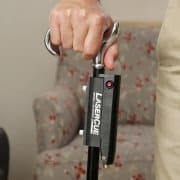Advancements in Parkinson’s Early Detection
Over the past several months, a surprising number of new innovations and research findings have come out related to early detection of Parkinson’s. While U-Step Neuro walking aids are always there for Parkinson’s patients, we rejoice every time new research comes out that makes early detection, treatment, and delaying symptoms of Parkinson’s possible. The following are the most recent promising and innovative advancements in Parkinson’s research that we are excited to share with you.
Mobile Apps
The advent of apps has certainly changed our lives, but is it possible that an app could help us detect early signs of Parkinson’s? Taking advantage of the various sensors in our smartphones today, iPROGNOSIS has created an app that uses these sensors to analyze voice quality, steadiness of hand, typing, and even facial expressions (from photos). While this app is still in testing phase, the insights gained could have a tremendous impact on the way in which we detect Parkinson’s in the future.
Typing
After studying a small set of individuals typing (some of whom had early signs of Parkinson’s) over several months researchers concluded that there are clear markers of Parkinson’s that can be determined by the way we type. Comparing one’s typing against the common frequency or simply by noticing hand tremors while typing, this useful tool could be one of the simplest ways to detect early signs of Parkinson’s for both doctors and individuals. While the results of this study are currently 78% accurate, the researchers are confident that given a larger research pool they can fine-tune their study and improve its accuracy.
Signs in the breath
Is it possible that one day we will simply be able to breathe into a tube and know if we’re showing early signs of Parkinson’s or any other neurological degenerative disease? Nanoparticle biosensor technology has advanced so much that the Israel Institute of Technology began studies to test the accuracy of a nanotube sensor array to detect early sign biomarkers of Parkinson’s disease. After computing their results, they compared their findings to midbrain ultrasound and smell detection tests, which are the current standard for testing for early stages of PD, the researchers are hopeful that this breath test could become the new standard.
Retinal Scanning
Not all early signs of Parkinson’s are motor signs. In a small study in South Korea, participants who were diagnosed with Parkinson’s but were not yet being treated were compared to an age-matched control group with retinal scanning. The results were consistent showing that the Parkinson’s patients had more retinal thinning in comparison to those in the age-matched control group. While this study shows a lot of promise standing on its own they are also looking into a connection between retinal thinning and a reduction in dopamine-producing cells by the brain (also associated with PD). It is believed that once the researchers are able to understand the connection between retinal thinning and dopamine that we will be able to monitor Parkinson’s treatments more accurately in the future.
The good news in all of this is that every year we are moving closer and closer to not only early detection but also hopefully, a cure. An early diagnosis might seem scary, however, the more vigilant we can be regarding early detection the more we can understand and prevent symptoms from interfering with patient’s lives. We at U-Step strive to give all of our customers more mobility, longevity and quality of life. And part of that mission is celebrating the hope for future elimination of Parkinson’s and other conditions altogether.












